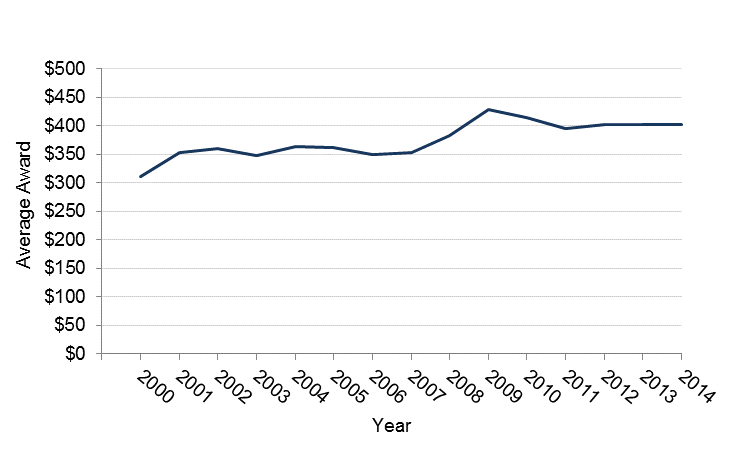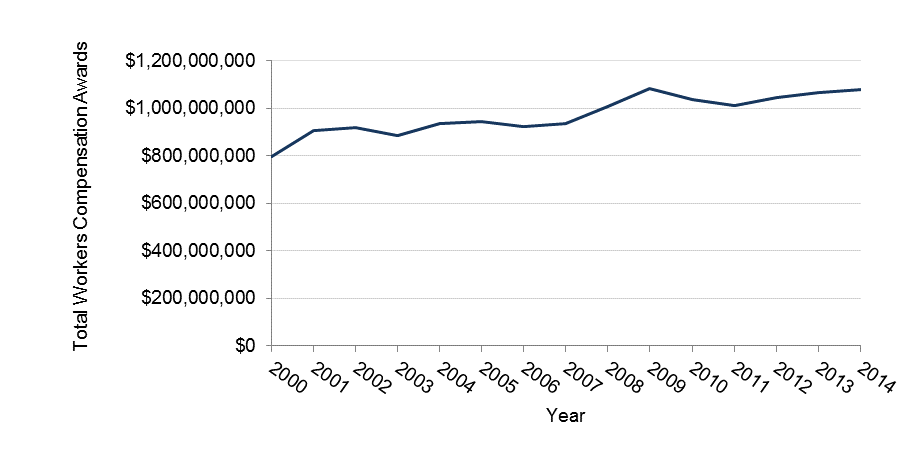Workers’ Compensation Awards
Workers’ compensation is a no-fault insurance system designed to pay for medical expenses, partial wage replacement, and rehabilitation for workers who are injured or suffer from illnesses that are work-related. Workers’ compensation also provides benefits to families of a worker who dies from a work-related cause. Each state has its own workers’ compensation system with its own rules, procedures, payment limits, record systems, etc. Current national data suggests that the number of individuals covered by workers’ compensation has increased and the number of claims has decreased, but the amount dispersed for each claim has increased over time. This could be due in part to increases in medical and wage-replacement benefits.
The Minnesota Department of Labor and Industry (DLI) oversees Minnesota’s workers’ compensation system and provides employers and employees with pertinent information regarding reporting an injury or illness and filing a claim. The DLI also provides many reports and annual updates on workers’ compensation claims in Minnesota.
Workers’ compensation claims are frequently used for estimating both the numbers and costs of work-related injuries and illnesses. However, the data may be incomplete as not every occupationally-related injury or illness will be reported. Specific industry and occupational classifications are exempt from coverage including self-employed individuals, corporate executives, domestic and agricultural workers, federal employees, railroad, longshore, and maritime workers. Not every claim is awarded compensation; each state has specific laws and regulation in place regarding the application for and dissemination of workers’ compensation awards. Differences in medical costs, wages, and mix of industries between states also have a significant influence on the amount of workers’ compensation awarded in a state. These factors, as well as other unaccounted for costs such as benefits, home production, and a reduction in quality of life, suggest that workers’ comp benefits will underestimate the true costs of occupational injury and illness within a state.
This indicator provides two measures of workers’ compensation benefits paid in Minnesota:
- the total amount of benefits paid out each year, and
- total amount of benefits divided by the number of workers eligible for workers’ compensation (this is not the same as the average amount of the individual benefits among workers who filed claims).
Summary data on workers’ compensation benefits by state and year are available from reports from the National Academy of Social Insurance. These data were used in the tables and graphs shown below.
Total and Average Workers’ Compensation Benefits Paid in Minnesota, 2000-2014
| Year | Workers’ Compensation Benefits | Average Amount Paid per Covered Worker |
| 2000 | $798,100,000 | $310.30 |
| 2001 | $908,000,000 | $352.52 |
| 2002 | $921,000,000 | $360.89 |
| 2003 | $883,619,000 | $347.61 |
| 2004 | $933,975,000 | $363.84 |
| 2005 | $945,888,000 | $362.82 |
| 2006 | $921,232,000 | $349.35 |
| 2007 | $936,085,000 | $352.57 |
| 2008 | $1,007,193,000 | $382.82 |
| 2009 | $1,082,620,000 | $429.44 |
| 2010 | $1,038,272,000 | $414.32 |
| 2011 | $1,011,017,000 | $396.01 |
| 2012 | $1,043,694,000 | $401.88 |
| 2013 | $1,064,684,000 | $402.83 |
| 2014 | $1,079,263,000 | $402.41 |
Total Workers’ Compensation Benefits Paid in Minnesota, 2000-2014
Total Workers’ Compensation Benefits per Covered Worker, 2000-2014

Trend analysis of the amount of workers’ compensation benefits paid from 2000 to 2014 demonstrates a statistically significant increase over the years. This is similar to what is seen at the national level and could in part be related to rising medical costs.
